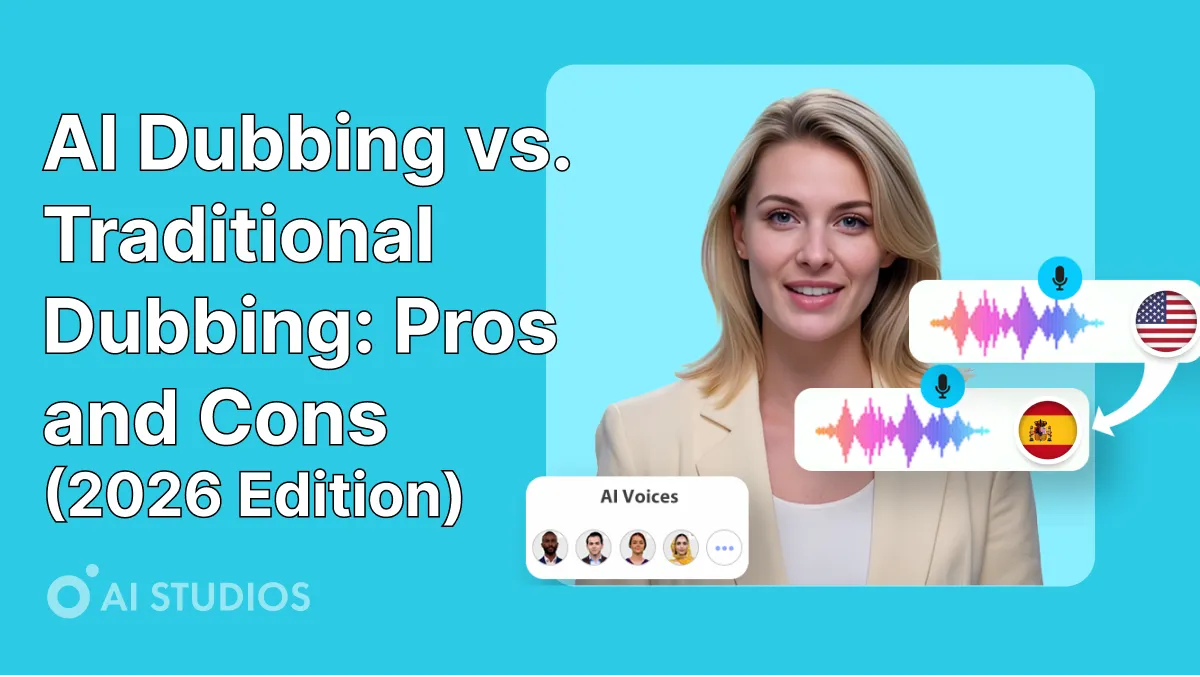
2026년에는 비디오 로컬라이제이션이 전 세계적으로 필수가 되었습니다.브랜드, 교육자, 제작자 모두가 같은 질문을 던집니다.
AI 더빙을 사용해야 할까요, 아니면 기존 더빙을 고수해야 할까요?
두 방법 모두 강점이 있습니다. 전통적인 더빙은 인간적인 뉘앙스를 가져다 주지만 AI 더빙 전례 없는 속도, 확장성 및 비용 효율성을 제공합니다.
이 문서에서는 품질, 소요 시간, 비용 및 워크플로우를 비교하고 어디에 있는지 자세히 설명합니다. AI 스튜디오 AI 더빙 들어맞다.
더빙이란 무엇인가 (그리고 왜 중요한가)
더빙 비디오의 원본 오디오를 번역된 버전 (일반적으로 다른 언어) 으로 대체하는 프로세스입니다.
다음과 같은 경우에 필수적입니다.
- 🌍 로컬라이제이션 (글로벌 시장 진출)
- 🎓 교육 및 훈련 콘텐츠
- 📺 엔터테인먼트 및 광고
- 🏢 지역 간 기업 커뮤니케이션
목표는 간단합니다. 콘텐츠의 사운드를 원래대로 만드는 것입니다. 자체 생산 다른 언어로.
AI 더빙이란 무엇입니까?
.webp)
AI 더빙 인공 지능을 사용하여 번역, 음성 생성 및 립싱크를 자동화합니다.
녹음 스튜디오와 성우가 필요 없기 때문에 기존 더빙보다 빠르고 저렴한 대안을 제공합니다.
다음과 같은 플랫폼 AI 스튜디오 DeepBrain AI는 다음과 같이 시장을 선도하고 있습니다.
- 🌐 150개 이상의 지원 언어
- 🧑 💼 2,000개 이상의 AI 아바타
- 🎞️ 7,000개 이상의 맞춤형 비디오 템플릿
AI 더빙은 로봇 음성에서 진화했습니다. 감정적으로 표현되고 자연스럽게 들리는 연설 — 실제 인간 더빙과 구별할 수 없는 경우가 많습니다.
전통 더빙의 작동 원리
- 스크립트는 수동으로 기록 및 번역됩니다.
- 감독, 사운드 엔지니어, 원어민 성우가 새로운 대화를 녹음합니다.
- 편집자는 새 오디오를 입술 움직임과 동기화합니다.
- 비디오가 리믹스되고 다시 렌더링됩니다.
이 프로세스는 정확하고 표현력이 뛰어나지만 시간이 많이 걸리고 비용이 많이 들며 물류적으로 복잡합니다.
AI 더빙과 전통 더빙: 비교표
.webp)
AI 더빙의 장단점
✅ 장점
- 동영상 번역 및 더빙 몇 분 안에
- 지지대 150개 이상의 언어 및 억양
- 음성 클로닝 톤을 일관되게 유지합니다.
- 끊김 없는 립싱크 및 자막 정렬
- 최대 90% 비용 절감 vs. 스튜디오 더빙
- 브라우저에서 직접 작동 — 소프트웨어 설치 불필요
❌ 단점
- 복잡한 이야기에서는 여전히 감정적 깊이가 약간 제한될 수 있습니다.
- 틈새 방언에 맞게 악센트를 미세 조정해야 할 수도 있습니다.
- 최상의 트랜스크립션 정확도를 위해서는 선명한 소스 오디오가 필요합니다.
전통 더빙의 장단점
✅ 장점
- 인간 행위자가 제공합니다 감정적 뉘앙스와 문화적 맥락
- 이상적 대상 영화, 드라마, 캐릭터가 많은 콘텐츠
- 엔터테인먼트 로컬라이제이션을 위한 업계 표준
❌ 단점
- 매우 비싼 과 느린
- 필요 스튜디오, 디렉터, 편집팀
- 스케줄링 충돌 생산 지연
- 여러 언어로 동시에 확장하기 어려움
각 방법을 사용하는 경우
시나리오 권장 방법 이유마케팅 캠페인AI 더빙더 빠르고 확장 가능하며 비용 효율적입니다기업 교육 비디오AI 더빙시장 전반에서 일관된 어조온라인 학습 과정AI 더빙빠른 번역 및 현지화장편 영화/TV 프로그램전통 더빙감성적인 스토리텔링과 연기의 깊이소셜 미디어 클립AI 더빙인스턴트 다국어 콘텐츠
선택 이유 AI 스튜디오 AI 더빙
.webp)
AI 스튜디오 의 선도적인 올인원 AI 더빙 플랫폼입니다. 딥브레인 AI, 번역, 음성 복제 및 사실적인 아바타를 단일 환경에 통합합니다.
🔹 주요 특징
- 150개 이상의 언어 지원
- 음성 클로닝 일관된 음색을 위해
- 2,000개 이상의 아바타 과 7,000개의 동영상 템플릿
- 자동 립싱크 및 자막 생성
- 브라우저 기반 HD/4K 비디오 내보내기
💰 가격 개요
플랜 설명 가격무료 플랜제한된 크레딧으로 더빙 해보기$0스타터 플랜개인 및 소규모 팀용~$30/월비즈니스/엔터프라이즈대규모 현지화용맞춤 가격
실제 사례
글로벌 SaaS 기업 사용 AI 스튜디오 AI 더빙 제품 데모를 다음 언어로 번역하기 10개 언어.
결과는?
- 비용 절감: 92% 저렴 스튜디오 더빙보다
- 소요 시간: 5일에서 45분 →
- 참여: 시청률 180% 증가 신규 시장에서
2026년 더빙의 미래
AI는 인간과 기계 표현 사이의 간극을 빠르게 메우고 있습니다.
2026년 말에는 다음과 같은 결과가 나올 것으로 예상됩니다.
- 생방송을 위한 실시간 AI 더빙
- 감정 인식 음성 합성
- 문화적 의도를 보존하는 문맥 번역
AI와 기존 더빙의 경계는 계속 흐려지겠지만 비용, 속도 및 규모로 인해 대부분의 글로벌 애플리케이션에서 AI 더빙이 앞서갈 수 있게 될 것입니다.
최종 판결
최신 비디오 워크플로의 95% 에서 AI 더빙이 이긴다 실용성과 ROI 모두에서.
그리고 최첨단 AI 더빙 플랫폼을 원한다면 AI 스튜디오 타의 추종을 불허하는 현실감과 유연성으로 앞서갑니다.
자주 묻는 질문
1.AI 더빙이 정말 기존 더빙을 대체할 수 있을까요?
대부분의 기업, 마케팅 및 온라인 학습 비디오의 경우 — 예.AI 더빙은 사람의 더빙과 거의 구별할 수 없는 자연스러운 음성 품질과 동기화를 제공합니다.
2.AI Studios는 하나의 비디오에서 여러 음성을 지원하나요?
네.단일 비디오 내에서 다른 스피커 또는 아바타에 다른 음성을 할당할 수 있습니다.
3.AI Studios의 립싱크는 얼마나 정확한가요?
AI Studios는 입술을 번역된 음성과 동기화하는 고급 딥 얼라인먼트 모델을 사용합니다. 프레임 레벨발음이 다른 여러 언어에서도 사실적인 결과를 제공합니다.
차세대 더빙을 직접 경험해 보세요. AI 스튜디오 AI 더빙 글로벌 커뮤니케이션이 얼마나 수월한지 확인해 보세요.



